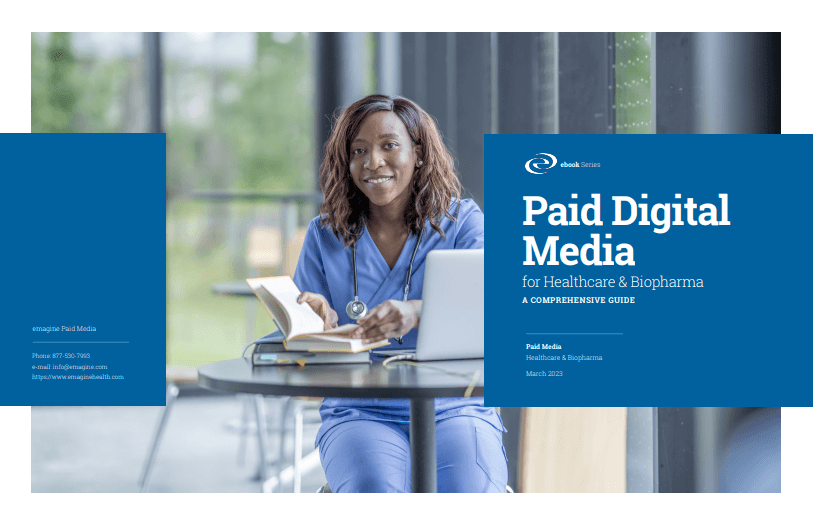eBook: Paid Digital Media for Healthcare & Pharma

A Comprehensive Guide to Paid Digital Advertising in Healthcare and Pharma
In the ever-evolving landscape of healthcare and pharma, where innovation and regulation coexist, digital marketing has emerged as a powerful tool for connecting with patients, healthcare professionals (HCPs), investors, and the wider audience. However, navigating this landscape requires more than just a presence; it demands a strategic, data-driven approach that maximizes return on investment (ROI) while adhering to strict regulatory guidelines.
This comprehensive guide is your compass through the complexities of digital marketing in healthcare and biopharma. We’ll explore the dynamic digital landscape, delve into the role of paid media, dissect key channels like PPC, paid social media, and programmatic advertising, discuss common pitfalls, provide insights on navigating regulatory hurdles, and guide you in building a holistic digital strategy.
The Landscape of Digital Marketing in Healthcare and Biopharma
Understanding the broader digital marketing landscape in healthcare and pharma is essential to grasp the significance of paid media. Over the past years, digital marketing has witnessed significant growth, revolutionizing the way organizations in these sectors communicate and engage with their target audiences.
Importance of Paid Media in the Digital Ecosystem
In the digital ecosystem, paid media complements organic strategies like SEO and content marketing. While organic methods are vital for long-term growth, paid media offers immediate visibility and precision targeting.
One key advantage of paid media is its ability to deliver measurable ROI. Paid campaigns can be tailored to achieve specific goals, whether it’s driving website traffic, generating leads, or promoting new treatments.
PPC and Paid Search
Defining PPC and Its Importance
Pay-Per-Click (PPC) advertising is a cornerstone of digital marketing, especially in the healthcare and pharmaceutical sectors. PPC allows advertisers to bid for ad placement in search engine results when users enter relevant keywords. When a user clicks on the ad, the advertiser pays a fee, making it a cost-effective way to drive targeted traffic.
Search Engine Market Share: Google vs. Bing
The choice of search engine for PPC is crucial. Google and Bing are the major players in this arena, each offering its unique advantages.
Google: Dominating the search engine market, Google provides extensive reach, ensuring that PPC ads can reach a wide and diverse audience.
Bing: Often underestimated, Bing offers cost-efficiency, making it an attractive option for healthcare advertisers aiming to maximize their budget.
Regulatory Concerns and Guidelines
PPC advertising in healthcare and pharma is subject to stringent regulations. Advertisers must accurately represent healthcare products, disclose potential side effects, and avoid misleading claims to comply with healthcare laws.
Tips for Effective PPC Campaigns in Healthcare and Pharma
Successful PPC campaigns in healthcare require a strategic approach:
- Keyword Research: Identify the terms your audience is searching for.
- Quality Score Optimization: Focus on creating relevant ad copy and landing pages.
- Ad Extensions: Use extensions to provide additional information.
- Ad Copy Compliance: Ensure ad copy complies with healthcare regulations.
- Landing Page Optimization: Optimize landing pages for speed and mobile-friendliness.
Paid Social Media
Differentiating Paid Social Media from Organic Reach
In the realm of healthcare and pharma, paid social media advertising plays a significant role alongside organic reach efforts. While organic reach relies on building a follower base and engaging through non-paid posts, paid social media allows advertisers to promote content directly to their target audience.
Platforms for Paid Social Media Advertising
When it comes to paid social media, several platforms are instrumental in reaching diverse audiences:
- Facebook: With over 2 billion monthly users globally, Facebook is a powerful platform for reaching consumers and patients. It’s also favored by users aged 35 and older.
- LinkedIn: LinkedIn excels at connecting with healthcare professionals, making it an essential platform for industry-specific targeting. It’s highly effective for sharing industry news, research, and perspectives.
- Twitter: In the healthcare, biopharma, and biotech sectors, Twitter is a hub for discussions about patient advocacy, medical research, and new treatments. With millions of daily active users, it’s a platform worth considering.
- Instagram: Healthcare companies use Instagram to educate patients, build credibility, and recruit employees. It’s a platform where patients often share their experiences and connect with others facing similar health challenges.
Guidelines and Restrictions
In healthcare advertising on social media, adherence to guidelines and restrictions is critical. Platforms like Facebook and LinkedIn have specific policies related to healthcare advertising to ensure the dissemination of accurate and safe information.
Navigating these guidelines while delivering compelling and informative content can be challenging but is essential for maintaining trust and credibility within the healthcare industry.
Programmatic Advertising
The Essence of Programmatic Advertising
In the fast-paced world of healthcare and pharma, reaching the right audience at the right time with the right message is paramount. This is where programmatic advertising shines. Programmatic advertising leverages data and technology to automate the buying of digital ads, targeting them to specific audiences in real-time.
Benefits of Programmatic Advertising
- Precision Targeting: Programmatic allows you to define your target audience with precision, ensuring that your message reaches those most likely to engage.
- Real-Time Optimization: Campaigns can be adjusted in real-time based on performance data, maximizing ROI.
- Cost-Efficiency: Programmatic often delivers better cost-efficiency compared to traditional ad buying methods.
- Cross-Channel Reach: Programmatic extends beyond display ads, encompassing video, social, and even audio advertising.
Overcoming Challenges in Programmatic Advertising
While programmatic offers tremendous benefits, it’s not without challenges, especially in the healthcare sector. Advertisers must navigate privacy concerns, data security, and compliance with healthcare regulations.
Additionally, brand safety is crucial. Advertisers must ensure that their ads do not appear alongside content that could damage their reputation.
The Role of Data in Programmatic Advertising
Data is the backbone of programmatic advertising. By harnessing data on user behavior, preferences, and demographics, advertisers can deliver highly personalized and relevant messages. Data-driven decisions lead to more effective campaigns and better engagement.
Common Pitfalls in Digital Marketing for Healthcare
Avoiding Pitfalls for a Successful Campaign
Successful digital marketing in the healthcare and pharmaceutical sectors requires careful navigation to avoid common pitfalls. Here are some pitfalls to be aware of:
- Generic Goals: Setting specific, measurable goals is essential. Whether it’s lead generation, appointment scheduling, or another objective, clear goals help measure performance.
- Not Tracking Goals: Beyond clicks and impressions, tracking conversions is vital. Knowing where leads come from and their source is crucial for assessing campaign success.
- Not Knowing the Value: Understand the value of acquiring a new lead, customer, or patient. Calculate the ROI to determine the effectiveness of your campaigns.
- Not Optimizing the Campaign: Paid campaigns require continuous optimization. Regularly review keywords, ad copy, and bid strategies to improve performance.
- Doing Too Much: Focus on a select group of effective keywords rather than an excessive list with low traffic and conversions.
- Not Having a Good Website: A poorly designed and slow website can negate the effectiveness of paid campaigns. Invest in a user-friendly, fast-loading website.
- Giving Up Too Early: Paid campaigns require experimentation. Allow time to collect data and make adjustments for optimal results.
- Technical Mistakes: Seek professional expertise when handling complex campaign types and keywords. Technical mistakes can have long-term consequences.
Regulatory Hurdles in Digital Marketing
Navigating Regulations in Healthcare Advertising
Advertising in healthcare comes with unique challenges due to stringent regulations. Different platforms have varying guidelines, and advertisers must ensure compliance. Here are some platform-specific considerations:
- Google: Certain healthcare-related content may be prohibited, and certification may be required for advertising in specific areas like pharmaceuticals and prescription drugs.
- LinkedIn: Restrictions apply to ads promoting unrealistic health claims and prescription drugs.
- Facebook: Ads should avoid generating negative self-perception and may require pre-approval for specific healthcare-related content.
- TikTok: Advertisers must adhere to regional regulations and avoid providing medical advice.
- Twitter: Health and pharmaceutical products and services may face restrictions depending on the product, service, and target country.
Building a Holistic Digital Strategy
Key Elements of a Comprehensive Strategy
To excel in healthcare digital marketing, consider these key elements for a holistic strategy:
- Content Marketing: Position your organization as a thought leader with blogs, infographics, and white papers.
- Podcasting: Engage with industry leaders through podcasts to enhance audience engagement.
- Social Media: Use social media for community building and industry-related conversations.
- SEO: Combine paid search with SEO to uncover valuable keywords and optimize content.
- UX: Ensure a seamless and efficient user experience on your website, especially when paid campaigns drive traffic.
By integrating these elements into your strategy, you can navigate the complexities of digital marketing in healthcare and biopharma effectively.
Navigating the Digital Waters in Healthcare & Pharma
In the ever-evolving landscape of healthcare and biopharma, one thing remains certain: the power of digital marketing cannot be underestimated. Our journey through this comprehensive guide has shed light on the critical role of paid digital media in reaching diverse audiences, from patients to healthcare professionals and investors.
Despite the unique challenges posed by strict regulations, a strategic and data-driven approach can lead to success in these industries. By harnessing the potential of PPC, paid social media, programmatic advertising, and other digital strategies, you can make a profound impact on people’s lives.
Take the Next Step: Download the Full eBook
Ready to dive deeper into the world of digital marketing in healthcare and biopharma? Our full eBook is a treasure trove of insights, case studies, and expert advice. Discover how to craft a holistic digital strategy that not only meets regulatory requirements but also delivers tangible results.
Click here to download the full eBook and embark on a journey toward digital marketing success in healthcare and pharma.
emagineHealth is the digital-first, AI-powered agency for healthcare and biopharma. Let’s work together to maximize the results of your digital advertising campaigns.

Paid Digital Media for Healthcare & Biopharma
In our newest ebook, Paid Digital Media for Healthcare & Biopharma, we discuss how to get in front of your ideal audience, the importance of targeting the patient and HCP journey, how to determine which platforms to focus on, and more.